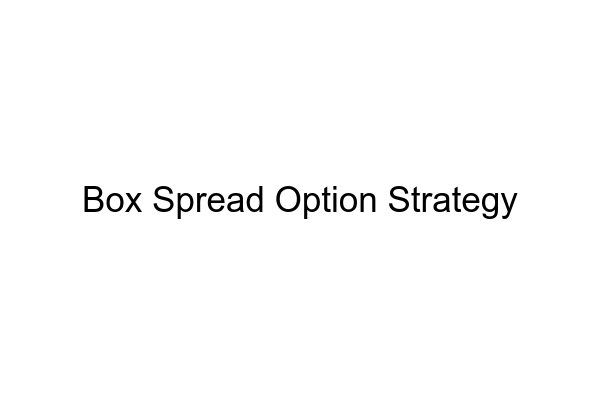Box Spread Option Strategy

What are the characteristics of this option strategy?
Box spread options are a set of four options contracts–two call options and two put options with the same underlying asset–intended to take advantage of discrepancies in the intrinsic value and time value of the options. It’s a type of collar strategy, consisting of a 2 collar options, one purchased at a lower strike price, and the other at a higher strike price. All the options are of the same expiration date.
Is this a bullish, bearish or neutral strategy?
The box spread option strategy is a neutral strategy. Neither calls nor puts have a directional bias here.
Is this a beginner or an advanced option strategy?
Box spread options are an advanced strategy, not suitable for beginners. This strategy relies heavily on market volatility, and an investor needs to understand option pricing and the concepts of Delta and Gamma to use this strategy effectively.
In what situation will I use this strategy?
The ideal situation for this strategy is when there is a very small discrepancy between the intrinsic values of the options. If there is price volatility associated with the underlying asset, this difference in intrinsic values can be exploited to generate profits. The basic goal of this strategy is to generate a risk-free profit or arbitrage in market pricing.
Where does this strategy typically fall in the range of risk-reward and probability of profit?
The box spread option strategy typically has a very low risk-reward and very high probability of profit. There is no directional bias and the cost of the long and short options cancels each other out, meaning that the investor’s risk is negligible.
How is this strategy affected by the greeks?
The primary factor that affects the box spread option strategy is the Delta of the option. Since the Delta of an option represents the rate of change of the option’s price, it should remain constant for an investor to make a profit from the box spread option strategy. Additionally, if the price of the underlying asset changes, it will also affect the overall profitability of the strategy.
In what volatility regime (i.e VIX level) would this strategy be optimal?
The box spread option strategy is most optimal in a low-volatility regime, with the Volatility Index (VIX) falling below 20. In this case, the Delta of the option will remain more or less the same, allowing the investor to take advantage of discrepancies in the intrinsic value of the options.
How do I adjust this strategy when the trade goes against me? And how easy or difficult is this strategy to adjust?
This is an arbitrage strategy. If entered correctly, the trade can never go against.
The box spread option strategy is relatively easy to adjust. The profit or loss for this strategy is known in advance and can be easily calculated. Additionally, adjustments can be made on the fly in response to sudden changes in market conditions.
Where does this strategy typically fall in the range of commissions and fees?
The commission and fees associated with the box spread option strategy will vary depending on the broker. Generally speaking, it is a relatively low-cost strategy due to the fact that the options purchased and sold cancel each other out.
Is this a good option income strategy?
The box spread option strategy can be used to generate income, but should not be considered an “option income” strategy. This strategy is best used to take advantage of discrepancies in the intrinsic value of options, rather than to generate income from time decay.
How do I know when to exit this strategy?
An investor should exit the box spread strategy when the price of the underlying asset movement begins to reduce the intrinsic value of the options positions. This can happen due to a sudden change in market conditions, or if the investor has held the options positions for too long.
How will market makers respond to this trade being opened?
Market makers will be aware of the box spread option strategy and may take steps to offset the profits made by the investor. However, since the profits generated from this strategy are typically small, the market makers may simply ignore the trade.
What is an example (with calculations) of this strategy?
Consider a stock trading at a price of $290. A trader can execute box spread option strategy by buying 1 call at $285 and selling 1 call option at $295. At the same time, the trader will buy sell 1 put at $285 and buy 1 put option at $295 The investor enters this trade by paying a net premium of $990. However the spread difference between two collar option is 10, which when multiplied by 100 lot size yields $1000. Hence the trader ends up locking $10 as arbitrage. If the commission is less than $10, investor will make money out of this.
Conclusion
The box spread option strategy is an advanced strategy, not suitable for beginners. This strategy is ideal for low volatility regimes, with the VIX index falling below 20. The strategy has a low risk-reward, and a high probability of profit. An investor should use a options profit calculator to calculate the potential profits from this strategy. MarketXLS provides investors the tools to track and analyze the markets, helping them make better informed trading decisions. MarketXLS’s options profits calculator is designed to help investors quickly and easily calculate the potential profits from an options trade. With MarketXLS, investors can analyze the markets and optimize their trading strategies.
Here are some templates that you can use to create your own models
Search for all Templates here: https://marketxls.com/templates/
Relevant blogs that you can read to learn more about the topic
Maximizing Profits with a Bull Put Spread Strategy
Options Profit Calculator
Get Ahead with Vertical Option Spread Strategies
Options Profit Calculator
